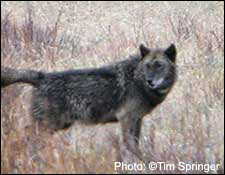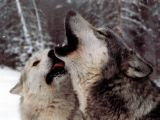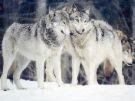
Welcome to another day of National Wolf Awareness Week!
As promised, I am bringing more wolf-related facts to you today.
General Wolf Facts
Wolves are mammals (Mammals - "Any of various warm-blooded vertebrate animals of the class Mammalia, including humans, characterized by a covering of hair on the skin and, in the female, milk-producing mammary glands for nourishing the young")
Wolves are carnivores (Carnivore - "A predatory, flesh-eating animal") Sounds much worse than it is. You and I are canivores though we may choose not to eat meat. Your dog or cat is also a carnivore.
A wolf's lifespan in the wild is approximately 6 to 8 years (though that is becoming shorter due to trapping, aerial hunting, and poisoning).
Wolf measurements (for lack of a better term):
Head and body is usually 36" to 63" (3 feet to slightly over 5 feet long)
Tail is usually 13" to 20" (just over 1 foot to just under 2 feet long)
Weight is usually 40 to 175 pounds (A good number of us shared our childhood homes and now share our beds with dogs who weigh that much!)
A wolf group is known as a "pack"
Protection status: Endangered. (For now. Recently removed from the Endangered Species Act and most recently returned to the list - but for how long?)
Wolf Society, Culture, and Rules of the Pack
There are typically 6 to 10 wolves in a pack. They live, hunt, and travel - sometimes up to 12 miles in a single day - together. Wolves don't regularly "sit down" to a daily dinner or big catch; therefore, when they do eat, they do not often eat in moderation. One single wolf can consume up to 20 pounds in one sitting. Sometimes, a wolf has to opt out for a much smaller meal such as a bird, fish, lizard, snake, or even fruit.
There is a strict rule of hierarchy (chain of command) in every wolf pack. There is a dominant (alpha) male who has first rank, and his mate does not follow far behind him. This alpha pair are usually the only breeding pair in the pack.
Remember the popular phrase "It takes a village to raise a child"? Well, that concept is alive and well within the wolf pack. Each adult wolf helps take care of and rear the new wolf pups. This can range from bringing the pups food or keeping watch over them while others in the pack are away on a hunt. Just imagine how this attitude, if applied to our culture and society, could transform our lives today. Our children could play outdoors without our supervision once more. They could walk to and from school safely. There would be no more school or college massacres. There would be no more child abduction or sexual predators. The list goes on.
That is just one of the many reasons why I have always admired the wolf, its societal structure, and its adherence to civility. The more I learn about the wolf, the more that I wish that we humans would take some lessons from the wolf and its societal norms. The more that we humans are left to our own devices and fight to be free of societal "norms" and social mores, the more I can see an alarming role reversal between predatory animals and humans.
Many more of you out there share this sentiment, I know, and it is evidenced each and every time someone thinks or says "I like my dog (dogs) and trust my dog (dogs) more than I like / trust humans."
Without wolves, we would not have our trusted dog friends, and if our dogs could weigh in on the issue of wolf protection and conservation, they would tell us to Save The Wolves Now!




No comments:
Post a Comment